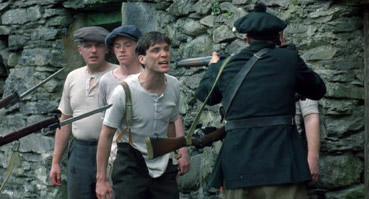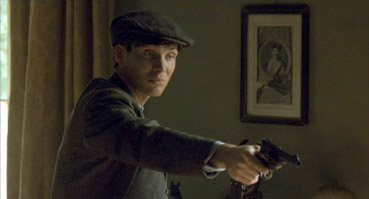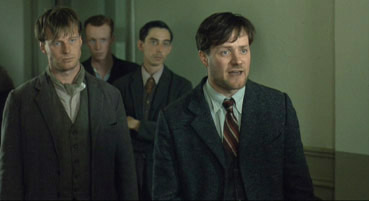| |
"If
a police barracks is burned or if the barracks already
occupied is not suitable, then the best house in the
locality is to be commandeered, the occupants thrown
into the gutter. Let them die there – the more the merrier. |
| |
"Should
the order ["Hands Up"] not be immediately
obeyed, shoot and shoot with effect. If the persons
approaching [a patrol] carry their hands in their pockets,
or are in any way suspicious-looking, shoot them down.
You may make mistakes occasionally and innocent persons
may be shot, but that cannot be helped, and you are
bound to get the right parties some time. The more you
shoot, the better I will like you, and I assure you
no policeman will get into trouble for shooting any
man." |
| |
Lt.
Col. Smyth, Divisional Commander for
the Black and Tans, June 1920* |
It
would be, it has to be said, disarmingly easy to make a
case against The Wind That Shakes the Barley
based on its first half-hour. It's an absolutely partisan
movie and never pretends to be otherwise, but its largely
one-sided presentation of this bit of Irish (and British)
history inevitably suggests over-simplification of a complex
situation. British soldiers are repeatedly shown brutalising
the locals, while the opposition are, it has been suggested
in some quarters, somewhat romanticised.
Consider
the opening ten minutes. It's 1920, and a group of very
likeable Irish boys return home after a hurling match and
are almost immediately descended on by a band of British
soldiers, who hold them at gunpoint, verbally and physically
abuse them and beat one of them to death for his non-cooperation.
One of the locals, Damien, is a promising young doctor,
a man prepared to dedicate his life to that most noble
of causes, the saving of human life, a polar opposite to
the brutes that invade his village, bad guys as evil as
any martial arts or Bond movie villains. In a later scene,
when the boys are forced to stay in hiding while more soldiers
descend on their home and attack their womenfolk, one of
the attackers actually laughs maniacally as he cuts the
hair from a woman's head. At this point the film genuinely,
for just one dangerous moment, risks teetering over into
melodrama.

It
is this seemingly unquestioning division between the good
and the bad that so riled certain quarters of the British
press. Well that and the fact the good guys here are members
of the Irish Republican Army, an organisation they regard
purely as terrorists and whose existence and actions they have no interest
in seeing justified in any way. And to suggest that British
soldiers would ever, ever behave in such a fashion is, they
believe, tantamount to treason.
And
yet history tells a rather different story. The Black and
Tans, as they were known, were recruited on the promise
of a good wage and were required to be ready to "face
a rough and dangerous task." They were first sent to
Ireland in 1920 to assist the Royal Ulster Constabulary,
who were coming under increasing attack from those fighting
for an independent Ireland, free of British rule. Although
many of the recruits were ex-WW1 soldiers, discipline and
especially self-discipline in the Black and Tans was poor,
and they responded to attacks on their numbers by terrorising
the local population, burning down buildings and carrying out
reprisal killings, fuelling a tit-for-tat war with the IRA
activists that only served to worsen relations
between the Irish population and the British occupying force.
It's
not a bad idea to read up on this stuff before approaching
The Wind That Shakes the Barley for the
first time, as it provides the context for the drama that
unfolds and a reasoning for the chosen viewpoint. Loach,
together with regular screenwriter Paul Laverty, are not
documentarians but dramatists, and their position here is
not to provide an even-handed history lesson, but to explore
the experience of living under and actively resisting a
sometimes brutal occupying army. While this theme has been
explored in any number of films in the past 60 years or
so, the response of the more conservative (re-) viewer seems
to dramatically shift when the oppressed locals fight back
under the banner of a united Ireland, and the oppressors
speak with English rather than German accents. And they really
are bastards here – the film's first quarter features a
succession of violent acts committed against civilians and
guerrilla fighters alike, from verbal abuse to violent assault
and torture (the second fingernail-pulling scene I have winced
through this year after Syriana). It's
certainly bludgeoning stuff, as it was no doubt meant to
be – at our cinema screening we had a number of walk-outs
even before the halfway mark was reached.

In dramatic terms
this provides justification for the first retaliatory acts,
but it soon emerges that Laverty and Loach's view of events
is far from the simplistic one that these early scenes or
their tabloid critics might suggest. The IRA's retaliatory action initially
inflames the conflict, taking and executing hostages has
serious moral consequences, and victory leads not to peace
but divisive in-fighting. It's a question facing all revolutionaries,
how to manage the peace if you win the battle, and what
compromises should you be prepared to make to maintain it. This is embodied (a little too neatly perhaps) in
brothers Damien and Teddy, initially united in the armed
struggle against the British but later increasingly divided
on the shape an independent Ireland should take.
Political
issues feature large in the second half, and it's once again
in the staging of group discussions that Loach's observational
approach shines the brightest, the documentary-like debates
presenting both sides of the topics under discussion in
a compelling and intelligent manner, much as they did in
earlier works such as Riff Raff and Land
and Freedom. The similarities to the latter film
(which was scripted by the late Jim Allen) extend to structural
and narrative elements and even specific scenes, and if,
for myself at least, The Wind That Shakes the Barley
stands a little in its predecessor's shadow, that should
not take anything from the younger film's considerable and
persuasive dramatic power.
As
ever with Loach, the performances are both naturalistic
and committed, the sometimes fierce but all-too-real aggression
of the Black and Tans coming not from drama school training,
but by having them all played by ex-British soldiers, men
trained and experienced in situations where forceful tactics
can be standard operating procedure. As Damien and Teddy,
Cillian Murphy and Padraic Delaney both give their all,
but special mention should go to Liam Cunningham as Dan,
the voice of experience and reason of the group and a reminder
of the contribution of organised labour to the cause, steadfast
non-compliance their key weapon.
The
Wind That Shakes the Barley has the qualities of
an angry polemic but is far smarter than such a label might
suggest. Although exploring events from the republican viewpoint
and providing repeated justification for retaliatory action,
it also suggests that this pulls both sides into a spiral
of violence that is destructive to all and ultimately
solves little. It's a lesson that is still relevant today,
wherever invading troops become armies of occupation (do
I really have to elaborate?), and it is this inevitable
association that really gives the film a topical bite, despite
its historical setting. It may not quite be up there with
the very best Loach (and that's a subjective call anyway),
but it's still a compelling and very impressively realised
piece from Britain's most politically cimmitted and consistently
impressive filmmaker, and one that, after seven nominations
lost out to others, thoroughly deserved the Palme D'Or win.
The
Anamorphic 1.85:1 is for the most part very good, but is
at times something of a mixed bag. At its best it boasts
impressive sharpness, contrast and colour, but on occasion
(usually dark interiors) is noticeably grubbier, with weak
contrast levels and visible compression atefacts. This can
vary from shot to shot, most evident in the prison scene,
where minor variations in lighting are dramatically amplified
by the transfer.

The 5.1 surround track is, as you'd expect for a Loach film,
a clearly recorded but low key affair, with with separation
and surround work kept to a minimum and never drawing attention
to itself. Music is effectively spread.
This
is a 2-disc release and the only extra feature of disc one
is a Commentary by Ken Loach and Historical Advisor Donal
O'Driscoll. Those of you who sat patiently through the lengthy
silences on Loach's commentary for Sweet Sixteen need not
worry – this is a far busier affair and an essential
companion to the film, with Loach and O'Driscoll providing
a great deal of historical and political background to the
drama, while Loach provides details on the
actors. A consistently interesting listen that deepened
my appreciation of the filmmakers' intentions and achievement.
On
disc 2 the main feature is the documentary Carry
on Ken (46:56), originally screened on Channel
4 (or was it More 4?) that provides an entertaining look
at Loach the film-maker, his career and working methods,
with contributions from many of those he has worked with.
The
Theatrical Trailer (1:55) is a
pretty good sell.
The
Photo Gallery has 20 press photos
for the film, all at a reasonable size.
If
you, like me, thought The Wind That Shakes the Barely
was a tad heavy-handed on the first viewing, then I strongly
recommend a little research and maybe even the Loach and
O'Driscoll commentary before giving it a second shot, and
I can almost guarantee you'll be more receptive to Loach
and Laverty's approach. It's not always comfortable viewing,
nor should it be, but it's still in my book a top contender
for best British film of the year.
As
for the disc, well it's the same old gripe, the words "2
disc Special Edition" on a release that could have
fitted the film and the only substantial disc 2 extra on
a single DVD. But it's a good documentary, and the feature
commentary is Loach's most informative and compelling yet.
So yes, it still comes recommended.
* Quoted from The History Learning Site
article, The Black and Tans, http://www.historylearningsite.co.uk/black_and_tans.htm
|